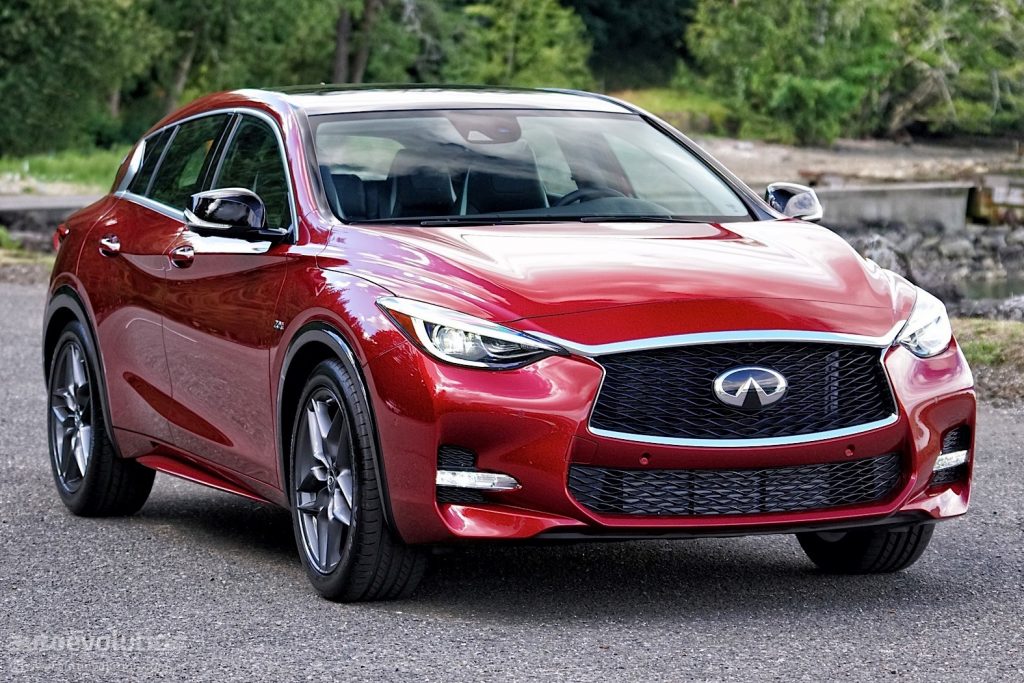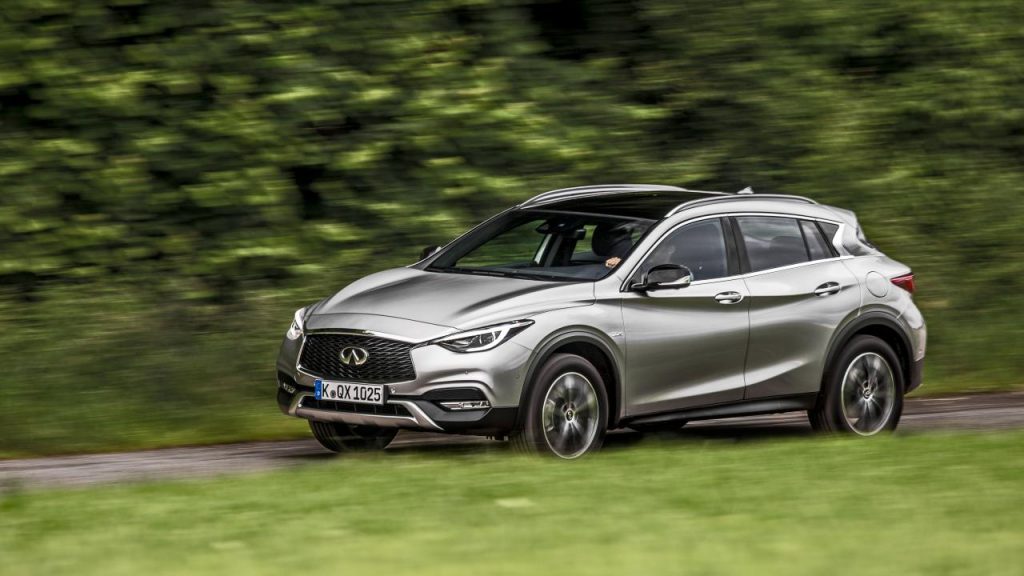“Think, satisfying and beautifully-crafted steering wheel; straight out of a C-class.”
That was my first impression upon getting in the soon-to-be-discontinued, 2019 Infiniti QX30. It’s been on the market since only 2017, and yet Nissan has announced it’s wrapping production by mid-2019. Blame a fatal combination of Brexit and slow sales for this model’s abrupt demise, as Nissan shifts export production away from its Sunderland, U.K. plant. Developed a few years back on Daimler’s Mercedes-Benz C/G-LA platform, the QX30 was designed to be a quick-and-dirty exercise in badge engineering (yep,the ’90s live on) to fill Infiniti’s void in the exploding compact/subcompact luxury SUV-market. But now that the drama surrounding Brexit has toppled multiple UK administrations – and without a deal remotely in sight – it’s unsurprising that large multinationals have moved to cut off export production from UK factories.
Truth be told, it’s not the biggest loss in the world, ‘cause the QX30 is not a standout in the compact luxury sport-ute class to begin with. It’s not bad, mind you. It’s perhaps a teeny bit more athletic in its responses than the GLA babyBenz with which it shares many components. But other than exterior design, there’s not a whole hell of a lot that’s different about it.

It sports most of the GLA’s interior switchgear, which isn’t a terrible thing compared to some of the low-rent componentry Nissan has passed off under Infiniti badges before. That said, it’s far from the best “Benz” interior we’ve seen, especially when compared to the artistry and craftsmanship on hand in the current C, E, and S-Class sedans, to say nothing of the class-leading GLE. Further, over SoCal’s laughably bad roads, this QX exhibited rattles with just a few miles on the clock.
Disappointing, yes, but not super-surprising; for starters, Nissan started with what was arguably the worst platform upon which a Benz logo is affixed (note: Mercedes recently introduced a redesigned CLA that is much-improved, and “feels” much more like a M-B product). Indeed, while this Infiniti subcompact is not as-cynical an exercise in badge engineering as the American jalopies of the 80s and 90s, it’s still a costumed intruder, which means it mostly has different styling and a few distinct features vis-à-vis the vehicle it’s based on.
But this, you see, presents a bit of a problem.
Had this pretender ute been based on the excellent C/GLC-class platform, it could have represented probably the best current product in the Infiniti stable. But, alas, it ain’t. Instead, it’s on the one Mercedes platform that, while a commercial success for Daimler, is widely regarded as a dynamic flop. Indeed, when one gets out of a C/G-LA, with their persistent rattles, a somewhat low-rent interior and not the traditional Benz thunk when you close the doors, one’s first thought is often,“that’s a Mercedes?” It’s just kind of obvious where the cost-cutting went down, which for something wearing the three-pointed star, is a bit…let’s say, surprising. Steering wheel aside, of course.

And as for that thick, satisfyingly-gripped, leather-wrapped wheel? Sadly, it offers almost nothing in terms of feedback or road feel, though it does have quick turn-in and a good amount of resistance. While the QX30’s moves aren’t ponderous, they aren’t athletic, either (though neither is the GLA itself). The QX’s firm ride might make you think it should be, though.
Further, the first-gen C/GLA and the derivative QX30 all demonstrate a somewhat similar sense of being good but not sufficiently rewarding to drive with abandon. We recorded only 18.1 mpg in mixed highway and city driving in our 300 miles with the car – kinda disappointing for a subcompact, four-cylinder ute. At least it’s peppy, with 60 mph arriving in 6.6 seconds, according to Car & Driver.
I’m sort of a rarity among auto journos in that I don’t absolutely despise stop-start systems, at least when they’re well-executed. And the QX30’s is decent, though startup is a bit on the rough side for a luxury application – it exhibited a rather un-Mercedes-like shudder every time it restarted. But at least the restarts are quickly executed. The QX’s 2.0L single-turbo four is otherwise a good engine; in this application, it produces 208hp and 258lb.-ft of torque over a fairly broad 1200-4000 RPM range, which is more than enough grunt to scuttle this 3200 lb. wagon – as soon as the tranny realizes what’s going on, that is. Sadly, this Benz mill is paired to Daimler’s in-house 7-speed dual-clutch transmission, which uncharacteristically hesitates between gearshifts when attempting to respond to abrupt throttle inputs, such as when you’re trodding along in freeway traffic that suddenly opens up and you engage the gas pedal in hopes of more urgent motivation. For a dual-clutch, the whole idea of which is supposed to be quick shifts, it’s somewhat dim-witted, which in any case is very un-Mercedes.
Overall, the QX and GLA are good but not class-leading products overall – especially in terms of packaging. The QX30 has a tight back seat, especially with two 6-foot+ adults up front; fitting 4 large adults would be tolerable for short distances only. It also has a small trunk, made all the worse by large D-pillars that obstruct a huge portion of the driver’s rear view; all part of that swoopy, Infiniti design language replete with its signature crescent-cut C-pillar. Thank God for parking alert sensors and other electronic nannies to keep you from getting careened by the oncoming Highlander. Infiniti, sadly, swapped the Benz mirrors for their own design-specific standard mirrors, which, in a cynical and presumably cost-saving move, do not include Mercedes’ in-mirror blind spot warning symbols but instead adopt Nissan’s bargain-basement system, located somewhere in the vehicle’s A-pillar (quick – see if you can find ‘em!). In the bright sunlight of Southern California, Nissan’s system is basically useless, and even when you can see the warning, is still something you need to remind yourself to look for – exactly the opposite of what you’d want of a warning light. Indeed, when changing lanes on the highway, you need to check two things now – the mirrors, and the swoopy A-pillars. I have the same complaint on my Q50 Red Sport, but it seems Nissan hasn’t gotten this complaint nearly enough. Or perhaps this is an area that could use some sensible regulation from DOT or NHTSA requiring BSW systems to be in the mirrors themselves (Dear Federal Government, is anyone home?)
But at what are sure to be healthy discounts to remove remaining production off the dealers’ books, the QX30 could represent a decent value for a swoopy little urban runabout (though our Luxe trim tester stickered for an eye-watering $41K, and at that rate didn’t even have a power moonroof (the sunshade slides back all the way, though)). Further, unlike any Nissan product in recent memory, it has power folding mirrors, so that’s a plus (at least for those of us who live in urban environments). And it has a certain charm to it, with curves that nothing else in the class comes close to matching. It’s just that from a driver’s perspective, it’s a little too half-baked to supplant the BMW X1 as the best vehicle in the segment.
Overall, a decent product – provided you can get a decent price. We look forward to testing the more-promising, all-new QX50 soon.
-BD , July 1, 2019